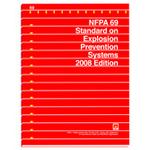Click here to purchase
Apply NFPA 69 to help prevent explosions due to combustible dust particles, gases, or vapors.
Combustible dust, gases, and vapors produced in industrial settings can pose a significant safety hazard. NFPA 69, Standard on Explosion Prevention Systems, offers definitive guidance on explosion protection and prevention systems.
This document is applicable to woodworking, grain processing (including sugar), and machining facilities, where combustible dust can spark explosions. It also covers facilities in which flammable liquids are used or petrochemical processing takes place — and explosions due to combustible gases or vapors are a concern.
Protected equipment includes pipes, ductwork, and dust collection systems.
Systems for explosion prevention, explosion isolation, oxidant concentration control, fuel concentration control, and ignition control are all designed in accordance with NFPA 69, which is also compatible with the terminology of NFPA 3, Recommended Practice for Commissioning and Integrated Testing of Fire Protection and Life Safety Systems, and other standards.
Essential for system designers, safety officers, insurers, municipal and state inspectors, and other professionals, NFPA 69 provides valuable insight on:
- Installing an explosion isolation valve or system
- Designing equipment to contain an explosion
- Controlling your process to help ensure an explosive atmosphere doesn’t develop
- Installing an explosion suppression system
- Controlling ignition sources in your process before an explosion occurs
Changes in the 2019 edition include:
- A revised adjustment for Limiting Oxygen Concentration (LOC) values obtained in flammability tubes, reconfirming a change made by a TIA
- New requirements that consider the concentration variation with time and location within the protected enclosure — as well as variations in operating conditions and material loadings — when using the combustible concentration reduction method of explosion prevention
- A new section on Safety Instrumented Systems (SIS), along with a requirement that explosion prevention system controls installed after November 5, 2021 be implemented as an SIS
- Added annex material that provides example calculations on how to estimate the LOC for a fuel or a fuel mixture
Follow the field’s best guidance for the prevention and control of deflagrations in the latest edition of NFPA 69. (Softbound, 90 pp., 2019)
Product Details
- Published:
- 03/01/2019
- Number of Pages:
- 97

